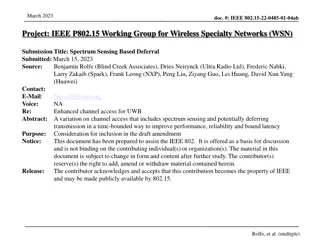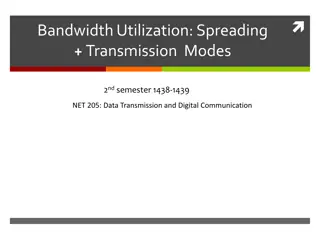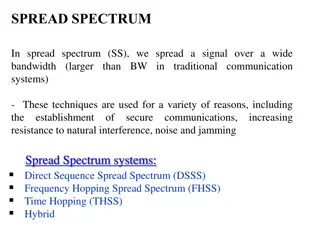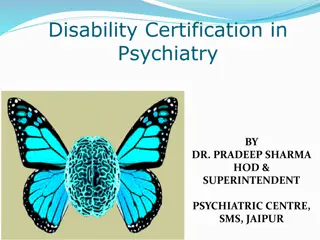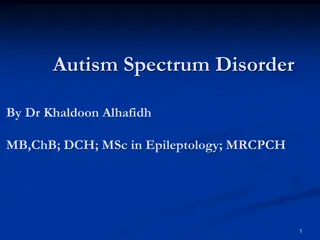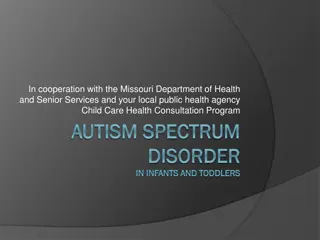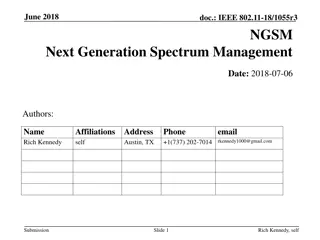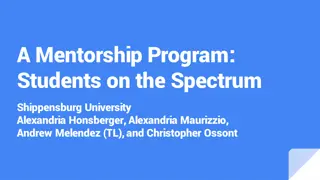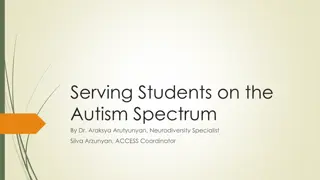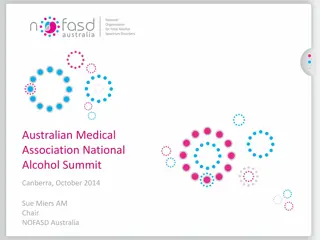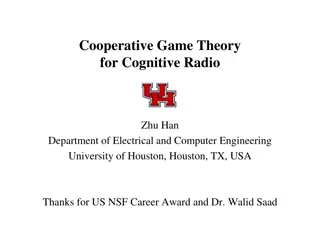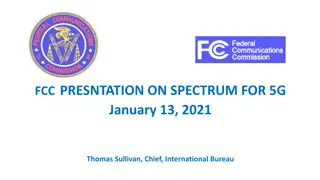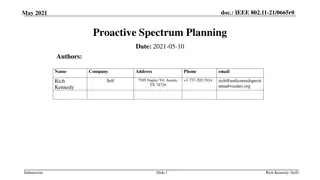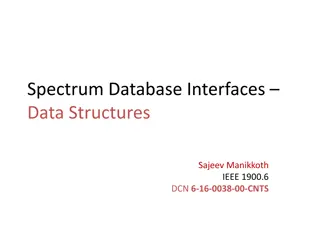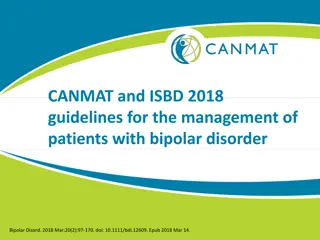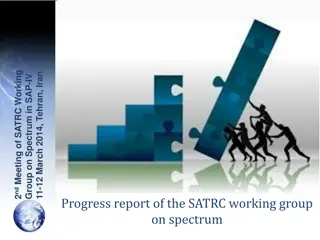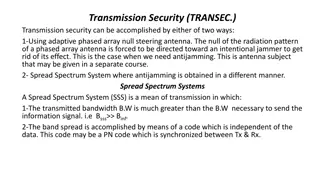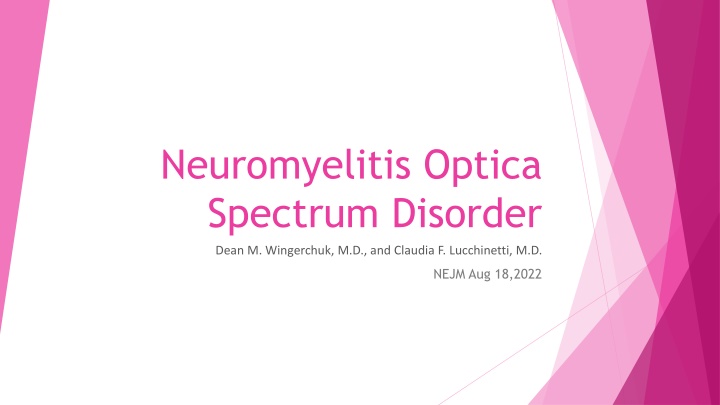
Neuromyelitis Optica Spectrum Disorder: Key Facts and Insights
Neuromyelitis Optica Spectrum Disorder (NMOSD) is a rare autoimmune condition affecting the central nervous system, primarily the optic nerves and spinal cord. Characterized by IgG-class antibodies targeting aquaporin-4, NMOSD differs from multiple sclerosis and has a chronic, relapsing course. This disorder accounts for a small percentage of CNS inflammatory demyelinating diseases and shows a female preponderance in seropositive cases. Clinical manifestations include optic neuritis, transverse myelitis, and area postrema syndrome. Early detection, accurate diagnosis, and tailored treatment are crucial in managing NMOSD.
Download Presentation

Please find below an Image/Link to download the presentation.
The content on the website is provided AS IS for your information and personal use only. It may not be sold, licensed, or shared on other websites without obtaining consent from the author. If you encounter any issues during the download, it is possible that the publisher has removed the file from their server.
You are allowed to download the files provided on this website for personal or commercial use, subject to the condition that they are used lawfully. All files are the property of their respective owners.
The content on the website is provided AS IS for your information and personal use only. It may not be sold, licensed, or shared on other websites without obtaining consent from the author.
E N D
Presentation Transcript
Neuromyelitis Optica Spectrum Disorder Dean M. Wingerchuk, M.D., and Claudia F. Lucchinetti, M.D. NEJM Aug 18,2022
Introduction Rare autoimmune disorder Multifocal central nervous system inflammation primarily affecting the optic nerves and spinal cord First described by Devic in 19thcentury
Initially thought to be a severe monophasic optic and spinal variant of multiple sclerosis that has spread to the brain Discovery of IgG-class antibodies that bind to the water channel aquaporin-4 (AQP4-IgG) in serum from patients with Devic s disease, but not from those with typical multiple sclerosis, established neuromyelitis optica as a distinct entity with a chronic, relapsing course
NMOSD accounts for 1 to 2% of all cases of CNS inflammatory demyelinating disease in the United States and Europe and one third or more of cases of CNS inflammation in Asian and other non- White populations. Median age at onset of the disorder is 40 years, but can affect people at any age Up to 20% of cases are in children or in adults over the age of 65 years The AQP4-IgG autoantibody is detectable in more than 80% of patients with NMOSD.
Seropositive disease has a 90 % female preponderance whereas seronegative cases have an equal sex distribution Up to 3% of cases are familial Approximately one third of cases are preceded by an infection, which is often viral, and in rare cases, an acute attack follows vaccination No specific infection or vaccine has been strongly implicated as a trigger of disease activity The initial attack has been associated with the use of immune checkpoint inhibitor therapies
Clinical characteristics Six core clinical syndromes which are classified by their location: 1. Optic nerve 2. Spinal cord 3. Area postrema of the dorsal medulla 4. Other brain-stem regions 5. Diencephalon 6. Cerebrum most common syndromes are optic neuritis, transverse myelitis, area postrema syndrome
The sentinel attack involves the optic nerve or spinal cord in more than 85% of affected adults. Patients with optic neuritis present with unilateral or bilateral visual loss or scotoma, dyschromatopsia and ocular pain exacerbated by eye movement Not distinguishable from optic neuritis in multiple sclerosis or from an idiopathic form
Acute transverse myelitis causes limb weakness, numbness, sensory loss or pain below the lesion level, and bladder and bowel dysfunction. Other myelitis symptoms include: Lhermitte s sign - trunk or limb paresthesia elicited by neck flexion 1. Episodes of paroxysmal tonic spasms lasting 15 to 60 seconds, with painful contraction of agonist and antagonist muscle which is often mistaken for convulsions 2. Severe high cervical myelitis can cause neurogenic respiratory muscle paralysis 3.
Area postrema syndrome is the presenting feature of NMOSD in 10% of patients Occurs at some time during the disease in 15 to 40% of patients Vomiting lasts a median of 2 weeks In up to two thirds of cases, presages an attack of optic neuritis or myelitis The syndrome can accompany myelitis when a destructive cervical lesion ascends into the brain stem, or it may be isolated and caused by nondestructive dorsal medullary lesions
Cerebral syndromes are common in children It causes generalized or focal signs, including encephalopathy, hemiparesis, hemianopia, or seizures Brain-stem lesions may cause oculomotor dysfunction, hearing loss, vertigo, dysarthria, or other cranial-nerve symptoms Lesions in diencephalic structures such as the thalamus and hypothalamus causes narcolepsy-like symptoms, endocrinopathies, temperature dysregulation, eating disorders, and a syndrome of inappropriate antidiuretic hormone secretion
Neuroimaging Confirmation of diagnosis is aided by MRI Acute phase: 1. T2-weighted MRI sequences : enlarging inflammatory lesions 2. T1-weighted sequences with gadolinium : enhancement of actively inflamed lesions
Orbital MRI lesions are seen in the optic chiasm or the adjacent posterior optic nerve but may occupy the full length of the nerve MRI of the spinal cord typically shows longitudinally extensive transverse myelitis defined as a lesion that is at least three contiguous vertebral segments in length 15% of sentinel myelitis attacks are associated with a shorter lesion that simulates multiple sclerosis Detection of a dorsal medullary lesion with the use of MRI is confirmatory of area postrema syndrome, but the lesion is small and visible for only a few days
A : A sagittal T2- weighted scan shows a longitudinally extensive cervical spinal cord lesion that extends into the medulla B : an area of ringlike contrast enhancement on T1-weighted imaging
Axial T1-weighted sequences with contrast material show increased signal along the length of the left optic nerve (C) and optic chiasm (D)
A sagittal fluid-attenuated inversion recovery (FLAIR) sequence shows increased signal in the dorsal medulla (E), which is associated with area postrema syndrome.
A pair of small foci of contrast enhancement on T1-weighted sequences confirms a relapse of acute area postrema syndrome (F).
An axial FLAIR sequence shows diencephalic lesions involving the hypothalamus
Large, confluent white-matter lesions, seen on an axial FLAIR sequence (H) Cloudlike contrast enhancement on an axial T1- weighted, contrast- enhanced sequence (I)
lesions involving the long axis of the corpus callosum, seen on a sagittal FLAIR sequence (J).
Diagnosis International consensus based criteria for the diagnosis of NMOSD requires the manifestation of one or more of the six typical syndrome and a positive serologic test for AQP4-IgG 80% of cases are seropositive
The standard serum AQP4-IgG reference test is a live cellbased flow- cytometric assay with more than 80% sensitivity and more than 99% specificity False positive low-titer results may occur with the use of enzyme- linked immunosorbent assays False negative AQP4-IgG results can occur if serum is sampled during immunosuppressive drug treatment or after plasma exchange Testing for cerebrospinal fluid AQP4-IgG is relatively insensitive.
Disease course Attacks of NMOSD usually reach peak severity in several days, plateau, and then spontaneously subside, frequently leaving moderate-to- severe and permanent functional deficits 90% of cases have a relapsing course Among women with seropositive NMOSD, relapse rates are higher during the first 3 months post partum than in the period before or during pregnancy, and the risk of miscarriage is increased.
Five years after the onset of disease: 1. 25% untreated AQP4-IgG seropositive patients require gait assistance 2. 40% are blind in at least one eye 3. 10% mortality
Association with other diseases Up to half of patients with NMOSD and AQP4-IgG have other detectable serum autoantibodies (e.g., thyroperoxidase, antinuclear, and Ro/SS-A antibodies) one third have an autoimmune disease, most commonly thyroiditis, systemic lupus erythematosus, or Sjogren s syndrome 5% cases are paraneoplastic
Pathogenesis AQP4 is an integral membrane water channel protein expressed by many cell types, including gastrointestinal, lung, retinal, renal, and muscle cells In the CNS, AQP4 is expressed on astrocytic end-feet that abut endothelial cells, which form the glia limitans component of the blood brain barrier
When the barrier is breached, or in regions such as the area postrema where it is lacking, circulating AQP4-IgG gains access and binds to its target antigen, initiating inflammatory responses that generate NMOSD lesions The pathological hallmark of NMOSD with AQP4-IgG is a focal inflammatory CNS lesion with marked or complete loss of AQP4
Therefore NMOSD is an autoimmune astrocytopathy where AQP4- specific autoantibodies initiate lytic and sublytic astrocyte disease with variable potential for reversibility A potential explanation as to why CNS is selectively affected is that CNS lacks protective complement regulatory proteins that are coexpressed with AQP4 in peripheral tissues such as the kidney
Acute relapse IV steroids For moderate to severe cases which respond incompletely to sterois plasma exchange maybe tried
Preventive immunotherapy Goal of NMOSD management : prevention of relapse Prevention of relapse will preserve long-term neurologic function Secondary progressive course of NMOSD, independent of relapses, is rare
Most frequently used drugs are rituximab, mycophenolate mofetil, and azathioprine Low-dose prednisone (or another glucocorticoid), methotrexate, mitoxantrone, or cyclophosphamide are also used
Monoclonal Antibodies Eculizumab Inebilizumab Satralizumab;
Eculizumab Inhibits C5 and presumably the formation of the membrane attack complex mediated by C5b Reduces risk of relapse by 94% as compared with placebo in AQP4- IgG seropositive adults The reduction in the risk of relapse in eculizumab monotherapy group was similar to the reduction in the group of patients who received eculizumab in addition to an established immunosuppressive therapy Upper respiratory tract infections and headache were more common in the eculizumab group No infections by encapsulated organisms such as Neisseria meningitidis; infections are a known risk of complement inhibition. One death occurred from pulmonary empyema.
Inebilizumab Targets CD19 Depletes a broad spectrum of the B-cell lineage, including antibody- producing plasmablasts and plasma cells than rituximab In a phase 2 3 trial that included AQP4-IgG seropositive and AQP4- IgG seronegative patients and did not permit concomitant treatment with immunosuppressive drugs, the risk of relapse was reduced by 73% overall and by 77% among seropositive patients Two patients died, one from a relapse of NMOSD and the other from an indeterminate CNS cause.
Satralizumab Targets the interleukin-6 receptor Two trials of satralizumab for the treatment of patients who have NMOSD with or without AQP4-IgG have been completed, one of which allowed concurrent immunosuppressive therapy Efficacy was achieved only in the seropositive groups in the two studies, with a 74% and a 79% reduction in relapse risk, and no deaths or cancers occurred.
Monitoring of AQP4-IgG titers or lesions seen on MRI is not currently recommended for therapeutic decision making, but serum biomarkers such as glial fibrillary acidic protein are being studied for confirming or predicting clinical relapse


